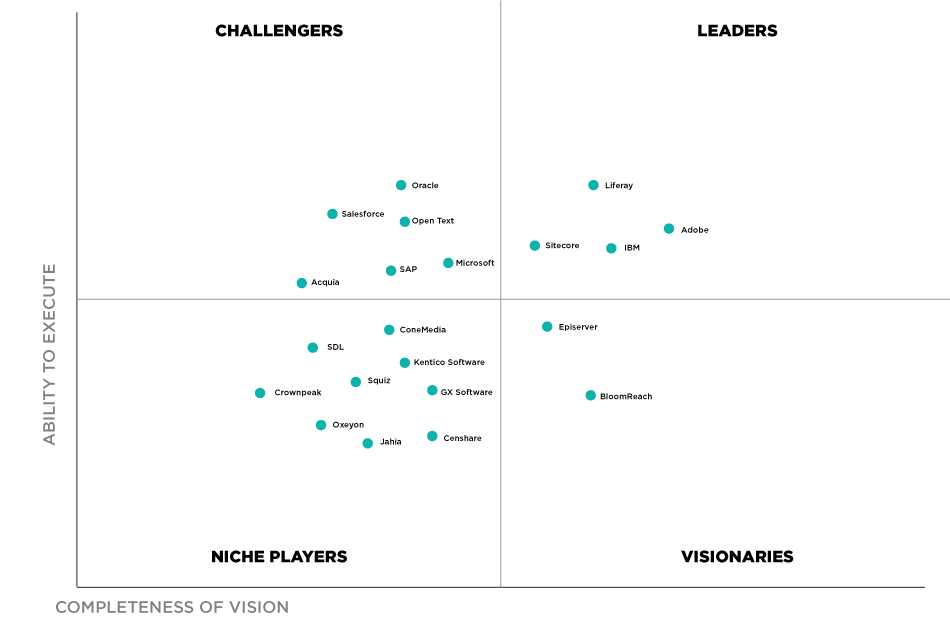Systems – Enterprise content management magic quadrant

Enterprise content management magic quadrant
What is the enterprise content management magic quadrant?
The magic quadrant (sometimes even abbreviated to MQ) is a series of market research reports published by Gartner every couple of years. These reports are intended to provide prospective software and technology buyers with a better idea as to the current landscape in a defined buying category.
Gartner get their insights and information through proprietary qualitative data analysis, which demonstrate and indicate market trends which should and could be informative to buyers.
From the above explanation about the magic quadrant, it should become clear what the enterprise content management magic quadrant is.
The enterprise content management magic quadrant is a magic quadrant focused on the ECM market, which gives prospective and current ECM buyers an overview of the current leaders, visionaries, challengers and niche players in the enterprise content management market specifically.
This ECM magic quadrant has two dimensions which Gartner 'ranks' each vendor on:
- Completeness of vision
- Ability to execute
Using these two dimensions, Gartner are able to position certain vendors in one of the 4 magic quadrants:
- Leader - A high ability to execute and a strong completeness of vision. Companies who live in this quadrant are well-established players with strong market share and credibility.
- Visionary - A high completeness of vision, but a low ability to execute. vendors who fit in this part of the magic quadrant are typically newer private companies who have come into the scene and established a strong market presence.
- Challenger - A high ability to execute but a low completeness of vision. Challengers are typically established and financially stable players who are likely entering the ECM market with a new or slightly modified product offering to capture this part of the market.
- Niche player - A low completeness of vision and a low ability to execute. Niche players are usually focused on narrow market segments like construction, or vendors who are adapting their product to the space.
You can see an example of the 2018 Gartner enterprise content management magic quadrant below.

What are the weaknesses of the enterprise content management magic quadrant?
All magic quadrants and landscape graphs share a number of strengths and weaknesses. The major strength of these types of illustrations is that they are easily interpreted and digestible.
A company or person looking to buy an enterprise content management solution can easily refer to and understand the magic quadrant.
It's incredibly easy for them to see and understand who the major players are in the space, and who some of the other important players are too. Maybe the particular buyer prefers working with more visionary companies who have a long term plan and more innovative approach to the problem of content management, or maybe they see a need for buying a niche solution which has been designed specifically for their industry.
The main weakness of the enterprise content management magic quadrant is that it is simple. Comparing complex and feature-heavy softwares on two high level and broad dimensions doesn't give buyers much insights into the actual solutions these companies are providing.
The ECM magic quadrant has often been criticised for catering to large investors and large vendors - more than catering to buyers.
As an example, Gartner may assume that a company of 1,000 people is in a better position to execute than a company of 50, and the company of 1,000 employees has a longer track record of execution.
But this doesn't factor in advances in the tools these companies use, the nature of the product or the efficiencies of their organisation. An incumbent ECM provider may need 3 or 4 more people to handle an account or customer than a more modern provider.
Another clear and valid argument against the magic quadrant is that the analysts and companies behind building the quadrants align the vendors with their framework rather than the other way around. This can skew the market unfairly, and also not provide buyers with the right dimensions they care about.
And lastly, the magic quadrant isn't very industry specific. Enterprise content management is a broad software category which buyers already have a hard time sifting through. A construction or mining company looking at the enterprise content management magic quadrant may see the 'leaders' as being the most suitable for them (given it's in the top right corner), when a niche provider who is building an ECM for them and can execute perfectly is overlooked.

How has the ECM magic quadrant evolved over time?
Gartner is constantly trying to update the ECM magic quadrant, and keep it relevant.
The biggest change which occurs with every new iteration of the magic quadrant is of course the vendors included. The enterprise content management market is always changing and so are the players. Changes to the softwares and tools available to the vendors themselves mean that new products come and go too.
One of the major recent changes to enterprise content management has been the user experience of the systems. In the past, big incumbent players produced softwares which were hard to use and hard to navigate. Recent vendors have introduced complex products which are easy to use - which is a massive and obvious value proposition for any buyer.
Referring to the weaknesses above, Gartner may also struggle to include this type of dimension.
In the last couple of years the enterprise content management magic quadrant has actually changed its name to be the "Content services platform" magic quadrant.
This change reflects the fact that enterprise content management is more about fitting multiple solutions together and creating a full suite of content management tools through integrations than simply buying a one-size-fits all content management system.
I'm sure the enterprise content management magic quadrant will continue to evolve and improve in the years to come, but it's important for ECM prospective and current buyers to pursue their own research too.
The ECM magic quadrant can't provide any buyer with enough detail or information about whether a certain ECM vendor is the vendor for them.
Enterprise content management is too big a piece of a business to rely on a simple quadrant, even if it is deemed magic.
People in 70+ countries use this ECM software to better manage their content and critical information.
